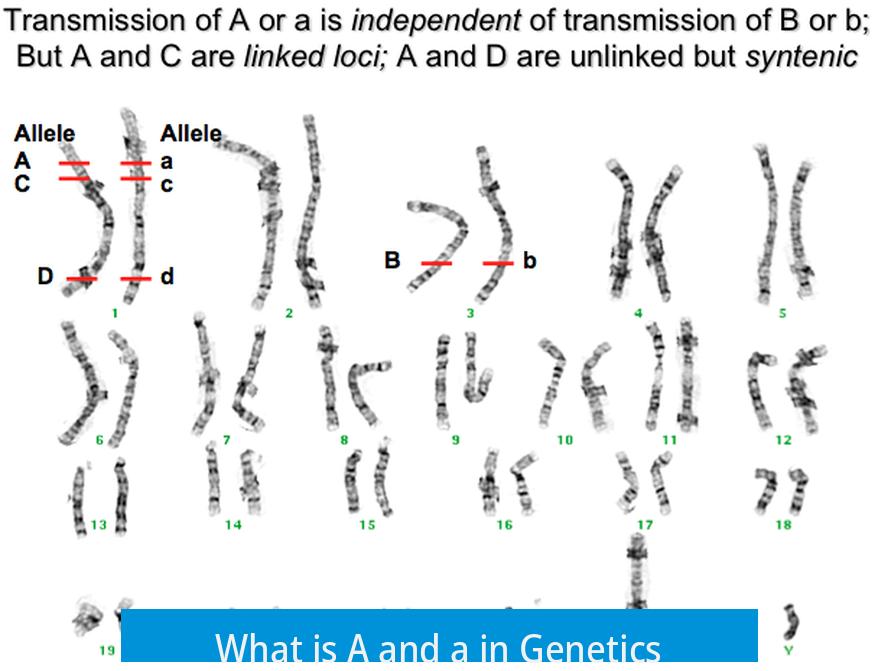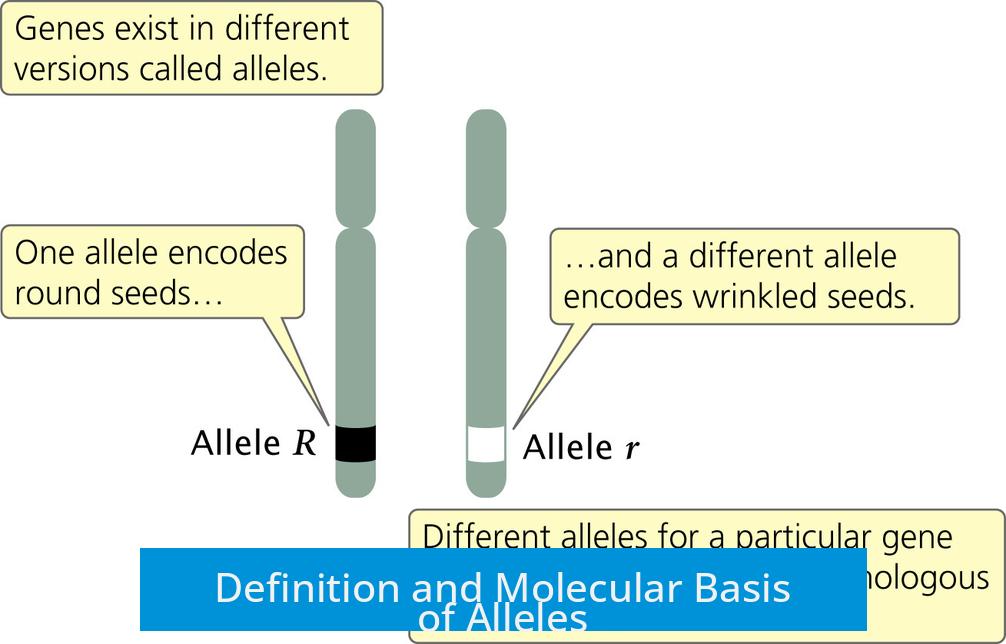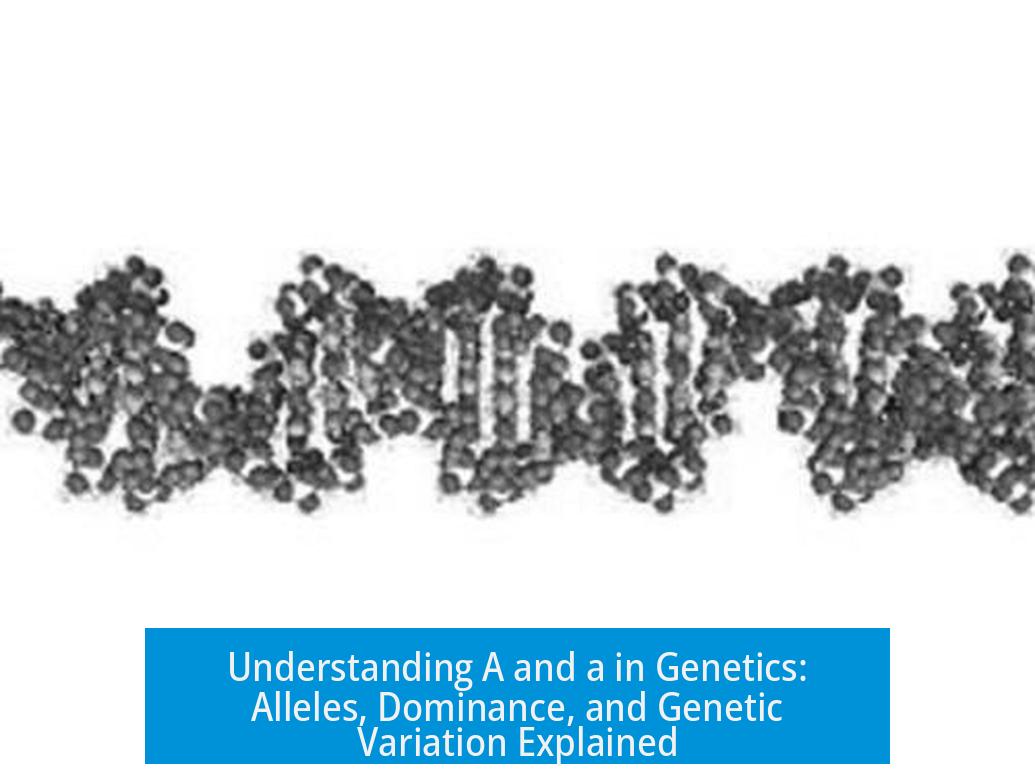What is A and a in Genetics?

A and a represent alternative alleles of the same gene in genetics, used as symbolic placeholders to differentiate between two versions of that gene. These alleles can vary at the DNA sequence level, causing differences in gene function, protein structure, or gene regulation. The letters A and a are commonly employed in Mendelian genetics to explain inheritance patterns, where A often symbolizes the dominant or normal allele, and a signifies the recessive or variant allele.
Definition and Molecular Basis of Alleles

What Are Alleles?
Alleles are different versions of the same gene present at corresponding locations on homologous chromosomes. Each individual typically carries two copies of every gene—one inherited from each parent. Alleles can differ in DNA sequence and affect the gene’s function.
Molecular Differences Between Alleles
- Single Nucleotide Substitutions: A single base change in the DNA, for example, ‘AACGTA’ versus ‘ACCGTA,’ can change the amino acid sequence of a protein, altering its structure and function.
- Insertions and Deletions (Indels): Indels can range from a few to thousands of bases. Even a one or two-base shift can cause a frameshift mutation, potentially disrupting the entire protein product.
- Synonymous Substitutions: Some mutations do not alter the amino acid sequence but can still influence gene expression or protein folding indirectly.
- Non-Coding Alleles: Many alleles occur in regions that do not encode proteins but regulate gene activity, affecting when and how much a gene is expressed.
Classical Mendelian Genetics Representation of A and a
A and a as Allele Placeholders
In classical genetics education, ‘A’ and ‘a’ function as simplified labels for two versions of a gene. They do not carry inherent meaning outside of their role as different alleles.
Relationship to Phenotype and Dominance
- Dominant vs. Recessive: Often, A is used to denote the dominant allele, which produces a functional protein. The recessive allele, a, frequently represents a nonfunctional or altered gene product.
- Wild Type vs. Mutant: Some conventions assign A to the wild-type or normal gene version and a to rarer, possibly pathogenic variants.
- Effect on Phenotype: The phenotype depends on whether the functional product of allele A can compensate for the defective allele a when both are present.
Punnett Squares Usage
These symbols aid in predicting trait inheritance by visualizing allele combinations. For a single gene trait, crosses such as A x a or Aa x Aa can reveal expected genotype and phenotype ratios.
Molecular Example of A and a in DNA Sequence
DNA Sequence Example with Premature Stop Codon
1 ATG GAC TTA AGC … 2 ATG GAC TGA AGC … ^
In this case, Sequence 1 and Sequence 2 represent the two alleles. The second allele contains a single nucleotide polymorphism (SNP) resulting in a premature stop codon (TGA), truncating the protein.
Interpretation
The difference between these two sequences exemplifies how the allele a might lead to a nonfunctional protein due to early termination, while allele A produces a fully functional protein. This aligns with the classical dominant-recessive model.
Simplistic Molecular View of A and a
At the molecular level, A and a often indicate a specific point mutation characterized by a nucleotide variant. For example, at a particular gene position, the wild-type allele could have a guanine (G), while the alternative allele contains a cytosine (C).
Relationship of A and a to Crossing Over and Recombination
Crossing Over Overview
Crossing over is a meiotic process where homologous chromosomes exchange genetic material. This recombination allows for genetic diversity but typically involves large chromosome segments, not just individual genes.
Low Probability of Crossover in Specific Gene Region
The chances of recombination occurring precisely at the locus of the A/a alleles are small. Recombination frequency is measured in larger chromosomal intervals, so allele identity remains mostly independent of crossing over.
Clarification on Relation to Recombination
Though alleles segregate due to the process of recombination, allele differences themselves do not influence crossover directly. Rather, recombination shuffles combinations of alleles along chromosomes during gamete formation.
Population Variation and Single Nucleotide Polymorphisms (SNPs)
Genetic Variation Between Individuals
On average, any two individuals differ at about 0.1% of their DNA sequences. This translates to roughly one difference every 1,000 base pairs.
Single Nucleotide Polymorphisms as Sources of Allelic Variation
SNPs are the most common source of allelic differences in populations. These polymorphisms originated through mutation and persist as natural variants. The A and a alleles can represent different SNP states at a single base position within a gene.
Summary of Key Points
- A and a are symbolic representations of alternative alleles of a single gene, frequently used in Mendelian genetics teaching.
- At the DNA level, they correspond to sequence variants such as single base changes, insertions, deletions, or regulatory region differences.
- Allelic differences impact protein coding and gene regulation, influencing the organism’s traits and phenotype.
- Classically, A often stands for the dominant or normal allele; a usually indicates the recessive or variant allele, though this is not a fixed rule.
- Crossing over induces chromosomal recombination but does not directly alter the identity of A or a alleles.
- Genetic polymorphisms such as SNPs cause allelic variation, contributing to population diversity.
What is A and a in Genetics? A Deep Dive into Alleles with a Twist
Simply put, A and a represent different versions of the same gene—commonly called alleles—in genetics. These letters are placeholders used to track how traits inherit and express themselves in organisms. But what does that really mean at the molecular level, and why do geneticists love these two humble letters? Let’s unwrap this with clarity, some fun, and a bit of science magic.
Imagine your genes as chapters in the instruction manual of life. Like any good story, some chapters come with minor edits—varying words, added or missing sentences—that can change how the plot unfolds. That’s where alleles ‘A’ and ‘a’ enter the scene. They signal these variations on the same gene story, shaping traits in unique ways.
Alleles – Who Are They Really?
Alleles are alternative versions of a gene. Humans carry two copies of each gene—one from mom, one from dad—except for a few fancy exceptions like males’ XY chromosomes. This double dose means you might have identical alleles (AA or aa) or a mix (Aa). “A” and “a” are symbolic flags to distinguish these variations without getting lost in the alphabet soup of gene sequences.
Molecular Tweaks Underlying A and a
Now, when you zoom into the DNA strands under a molecular microscope (or your imagination), these “A” and “a” versions differ by small but crucial changes:
- Single Base Substitutions: Picture the DNA code sequence as “AACGTA.” Swap one letter, and it becomes “ACCGTA.” That teensy change might swap an amino acid in the protein, warping the protein’s shape and function dramatically. Think of it like swapping an ingredient in a cake recipe—vanilla instead of sugar—bad idea for taste!
- Indels (Insertions/Deletions): Sometimes genetic editing is less polite and either adds or removes bases. A tiny deletion can shift the reading frame, causing a totally scrambled coded protein. It’s like a typo that shifts every word after it, making nonsense soup of instructions.
- Synonymous Substitutions: Here’s a sneaky one: changing a base, but still coding the same amino acid. No change on the protein surface? Not so fast! This can tweak how the gene turns on or off, influencing the trait indirectly.
- Non-Protein Coding Alleles: Not all genes program proteins. Some regulate other genes, and their alleles differ in how those regulatory signals work. It’s like a conductor waving a baton differently, changing the music tempo without playing an instrument.
The Classroom Classic: A is Dominant, a is Recessive?
In simple genetics lessons, “A” often means the dominant allele, driving the trait with one copy. “a” is recessive, often “broken” or less functional, needing two copies to show effect. But real genetics is a bit messier. Sometimes “A” just means the wild type (common, normal version) and “a” indicates a rare or disease-linked variant.
For example, if “A” encodes a working protein and “a” doesn’t, an individual with genotype Aa might still show the trait because the working protein from “A” does the heavy lifting. That’s dominance in action, not just letter symbolism.
Some Everyday DNA Drama: The Premature Stop Codon Example
Take two DNA sequences:
1 ATG GAC TTA AGC … 2 ATG GAC TGA AGC … ^
That TGA in the second sequence is a stop codon—a signal to halt protein production prematurely.
This premature stop means the protein gets cut short—a bit like stopping a film in the middle of the plot. If the first sequence is allele “A” (functional) and the second is “a” (non-functional due to the stop), the difference in protein length and functionality explains the phenotypic differences between individuals.
How About Crossing Over? Does A Mate with a?
Genes throw their own party during meiosis when chromosomes shuffle. However, the identity of these alleles (“A” vs. “a”) barely matters at the crossing-over event. Chromosomes cross over 1-2 times per meiosis, and each house thousands of genes. Chances that the swap happens precisely between “A” and “a” at this gene are low.
Basically, while crossing over shuffles chromosomes broadly, alleles are just along for the ride unless the swap happens right next door to them.
Allelic Variation in Populations: The SNPs Story
Humans differ genetically by about 0.1%, meaning one base in every 1,000 varies on average between two random people. These single base differences, called Single Nucleotide Polymorphisms (SNPs), are the main sources of allelic diversity like “A” and “a.”
These SNPs usually trace back to ancient mutations long stabilized as variants in populations. For instance, one person’s “A” allele might carry a G nucleotide while another’s “a” carries a C in the same gene spot. Such differences drive the diversity of human traits and disease risks.
Why Should You Care About A and a?
Besides being a staple in every high school biology class, understanding A and a alleles provides keys to unlocking how traits spread, how diseases might sneak in, and why genetic diversity matters. Knowing whether you carry a dominant “A” or recessive “a” could explain why you have blue eyes or why a family member faces a genetic disorder.
For parents-to-be, doctors, and genetic counselors, these alleles aren’t just letters but chapters influencing the health story of the next generation. For researchers, they are clues on which targets to focus when crafting gene therapies or studying evolution.
Wrapping It Up
- A and a are symbolic representations of alternative versions of the same gene. They act as genetic placeholders to help visualize inheritance patterns.
- Molecular differences between alleles range from single nucleotide changes to large deletions. These tiny changes can have huge impacts on the resulting protein or gene regulation.
- Classic genetics often treats A as dominant/normal and a as recessive/abnormal, but context matters. Gene function and expression tell the tale better than letters alone.
- Crossing over shuffles chromosomes broadly but rarely targets specific alleles exactly. Alleles hitchhike in the big genetic shuffle.
- Population SNPs underpin allelic variation, fuelling diversity in traits and disease susceptibility. Understanding this variation helps decode human biology.
So next time you see “A” and “a” in a genetics problem or science lesson, remember: behind those simple letters lies a world of molecular drama, evolutionary history, and biological mystery. It’s not just the alphabet; it’s the script of life, written in four letters, with endless variations.
Curious about your own alleles? Genetics might hold the answer to some of your quirks. Maybe one day “a” will explain why you can’t resist chocolate… or whether you really can catch your dad’s bad singing genes!





Leave a Comment